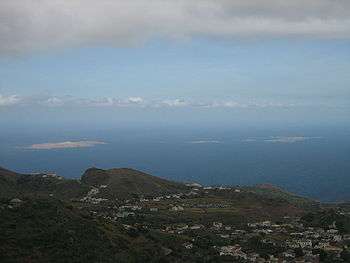Ilhéus Secos


The Ilhéus Secos (Portuguese for "Dry Islets", because of their aridity and paucity of vegetation), also known as the Ilhéus do Rombo, are a group of small, uninhabited islands in the Cape Verde archipelago, lying 600 km off the coast of north-west Africa in the Atlantic Ocean. They are sited on a volcanic seamount 7 km north of Brava and 15 km west of Fogo. The two major islets of the chain are Ilhéu Grande (300 ha) and Ilhéu de Cima (150 ha). Administratively they are part of the municipality of Brava. They can be seen from Brava and, sometimes, from Fogo.
Description
The larger islets have some sparse grassland. Ilhéu Grande is on the west side of the group. It has a length of about 1.5 km from south-west to north-east and a width of 600–800 m, with a small bay in the north-west. Ilhéu de Cima, on the east of the group, is about 1 km long and 500–600 wide, with a small bay in its south-east. Some smaller unvegetated islets and rocks, including the Ilhéu do Rei, Ilhéu Sapado and Ilhéu Luíz Carneiro, lie between them.
Fauna
Ilhéu de Cima is famous for its seabird colonies. Ilhéu Grande, which has been used by goat farmers and whalers in the past, does not currently support breeding seabirds, though large colonies must have existed formerly as the island has thick layers of guano. The island group has been identified as an Important Bird Area (IBA) by BirdLife International because it supports seabird colonies as well as peregrine falcons and Iago sparrows. Sea turtles have been reported to nest occasionally on the small, sandy beaches of Ilhéu de Cima.[1] Other fauna includes the gecko species Tarentola protogigas[2]
References
- ↑ "Ilhéus do Rombo". Important Bird Areas factsheet. BirdLife International. 2013. Retrieved 2013-08-11.
- ↑ Reptile Database, retrieved on 14 April 2014
Coordinates: 14°50′N 24°50′W / 14.833°N 24.833°W